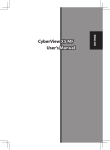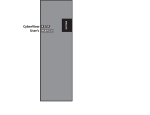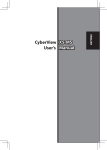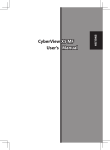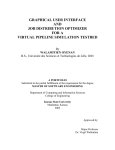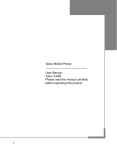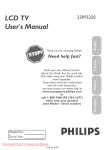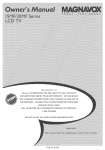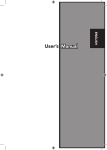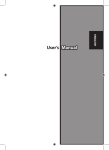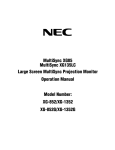Download Reflecta CyberView X5 MF User`s manual
Transcript
ENGLISH ENGLISH CyberView X5 User’s Manual 1 FEDERAL COMMUNICATIONS COMMISSION (FCC) STATEMENT ENGLISH This Equipment has been tested and found to comply with the limits for a class B digital device, pursuant to Part 15 of the FCC rules. These limits are designed to provide reasonable protection against harmful interference in a residential installation. This equipment generates uses and can radiate radio frequency energy and, if not installed and used in accordance with the instructions, may cause harmful interference to radio communications. However, there is no guarantee that interference will not occur in a particular installation. If this equipment does cause harmful interference to radio or television reception, which can be determined by turning the equipment off and on, the user is encouraged to try to correct the interference by one or more of the following measures: • • • • Re-orient or relocate the receiving antenna. Increase the separation between the equipment and receiver. Connect the equipment into an outlet on a circuit different from which the receiver is connected to. Consult the dealer or an experienced radio/TV technician for help. Warning : Use only shielded signal cables to connect I/O devices to this equipment. You are cautioned that changes or modifications not expressly approved by the party responsible for compliance could void your authority to operate the equipment. 2 2 TABLE OF CONTENTS 4 6 8 8 10 13 14 16 16 17 17 17 18 18 20 23 24 User Interface Menu Commands Scan Preview Image Adjustm Window Help Function Bar Diagram / Toolbar Diagram Active Frame Setting Area Technical Support 25 26 26 26 29 32 32 35 35 36 ENGLISH Getting Started Quick Installation Guide (QIG) Installing Software and Driver Installing Hardware Loading 120 Films into the Holder Loading 120 Film Holder into the Scanner Loading 135 Film into the Holder Loading 135 Mounted Slides into the Holder Loading 135 Film and Slide Holder into Scanner How to Scan STEP 1 - Powering On the Scanner STEP 2 - Select Film Type STEP 3 - Optional Prescan STEP 4 - Set Scan Settings STEP 5 - Set Scan Preferences STEP 6 - Scan STEP 7 - Exit 3 3 GETTING STARTED ENGLISH Check the package content before getting started. For Quick Installation please refer to Quick Installation Guide. (Pg. 9). Important! Save the original box, receipt and packing material for future shipping needs or to return for warranty issues. Package Contents • Scanner unit. • Medium format film holder for one or two frames (6 x 4.5 cm, 6 x 6 cm), one frame (6 x 7 cm, 6 x 8 cm, 6 x 9 cm, 6 x 12 cm). • 135 film holder. • 135 slide holder. • Power Adapter. Warning! Using any other power adapter may severely damage the scanner and will void the product warranty. • USB 2.0 Cable. • CyberView Driver. • Application software CD for scan editing. • Printed User’s Manual. NOTE: • Application software means the imaging software such as Adobe® Photoshop® Elements, this is subject to change without notice. GENERAL GUIDANCE: • • • • 4 6 Only use the supplied USB-cable. Connect the scanner to the computer directly using the USB 2.0 cable. Do not use a Hub or extension cable. Only use the USB ports on the back of desktop computers. If there are any other devices (multifunction device, printers, scanners, webcam) connected to the computer through USB disconnect them. A minimum of 1GB RAM (PC/Mac) is required. Operating Ambient Temperature Range 50º to 104ºF (10º to 40ºC) ENGLISH Note: Do not turn on the scanner unless it is within this range. If the scanner has been stored or transported outside of this range, allow it to return to within this range before turning it on. Operating Ambient Humidity Range 15% to 76% relative humidity (non-condensing) Note: If the scanner is stored or to be transported in cold temperature and then brought into a warm / humid environment condensation may occur. This device is designed solely for private use and is not intended for commercial use. The warranty is reduced from 2 years to 1 year if errors or defects arising from inappropriate use, improper operation or stress occur. The guarantee period of the device for private use is 2 years or 20,000 scans. 7 5 ENGLISH QUICK INSTALLATION GUIDE (QIG) Scanner - front view Power button Scan button Opening for 135 film & slide holder Opening for 120 film LED light Scanner - rear view USB 2.0 port Opening for 135 film & slide holder DC power 6 6 INSTALLING SOFTWARE AND DRIVER for PC (Windows) User ENGLISH WINDOWS SYSTEMS INSTALLATION: DURING DRIVER INSTALLATION A WARNING DIALOGUE BOX MAY APPEAR, IF THIS IS THE CASE PLEASE SELECT “INSTALL THIS DRIVER ANYWAY”. Be sure to install the Application Software (ex: Adobe® Photoshop® Elements) BEFORE installing the CyberView scanner driver software. You may install the scanner driver directly if you have already installed TWAIN compliant application software on your computer (i.e. photo editing software). Mac users can use iPhoto for editing. 1. Place the application software DVD into the DVD drive. If you have CD autoplay disabled, right click and select “Explore”. Select “AutoPlay.exe” and follow the on-screen instructions to complete the installation. 2. Place the CyberView CD into the drive. If you have CD/DVD autoplay disabled, right click and select “Explore” (ex.: D:\Install\Drivers\Package\CVX.exe), double click the file “CVX.EXE” and follow the on-screen instructions to complete the installation. 3. Restart your computer. 4. Once the drivers have been installed, connect the scanner. Verify that the scanner is switched OFF (light on the front is not lit) and connect the scanner to a power source. Then connect the scanner to a live USB port. When using desktop PC, connect the scanner to rear ports only, hub extensions and long USB cables are not supported. 5. Switch on the power. The scanner is now ready to work. Windows operating system should state “New hardware detected“, and should begin installing or request to select an option - select “Locate and install driver software”. NOTE: Not all PC’s will display the found new hardware window, some will install in the background. 7 7 INSTALLING SOFTWARE AND DRIVER for Mac (OSX) User Before Installing the scanner driver... ENGLISH If you choose to use the provided application for image editing, install the application software (ex: Adobe® Photoshop® Elements) by inserting the application CD into the computer’s CD/DVD drive. Follow the instructions that will be displayed in a window that opens automatically. If you have the iPhoto application (or other photo editing software) installed on your Mac, you can skip this step. Installing Scanner Driver a. Insert driver CD into the computer CD/DVD drive and look at the contents with “Finder”. b. Double click the ”CyberView ” icon to begin the installation process. Follow the onscreen prompts to complete the installation process. NOTE: Make sure the scanner is NOT connected to the computer during the CyberView driver installation. c. Restart the computer once the installation process is complete. INSTALLING HARDWARE for PC (Windows) and Mac (OSX) Users Connect the scanner to a power source: 1. Plug the AC adapter into an AC power source FIRST before plugging it into the scanner. 2. Attach the USB cable to the computer using the standard USB adapter end. Attach the USB adapter end of the cable to back panel of the scanner. 3. Switch on the power on the front side of the scanner. For instructions on loading film into holders continue on p. 11. If you are familiar with loading film into film holders skip to p. 18. 8 8 TWAIN scanner plug-in Installation Guide for Adobe Photoshop Elements 9 and newer versions Important: Do not move plug-ins from previous versions of Photoshop Elements into the Photoshop Elements 9 > Plug-Ins folder, or set the Photoshop Elements 8 (or earlier) > Plug-In folder as the Additional Plug-Ins Folder in Preferences. ENGLISH The TWAIN scanner plug-in is no longer installed with Photoshop Elements 9. In order to be able to import scanner device through Adobe Photoshop elements, please follow below instructions after installing Adobe Photoshop Elements 9 to find where and how to install the TWAIN component which was previously installed with the application for versions earlier than Photoshop Elements 9. Find complete information at official Adobe website: http://kb2.adobe.com/cps/849/cpsid_84933.html Macintosh To install the legacy TWAIN plug-in for Macintosh, copy TWAIN.plugin folder from: //Applications/Adobe Photoshop Elements 9/Optional Plug-Ins/ImportModules/ Into: //Applications/Adobe Photoshop Elements 9/Locales/<locale>/Plug-Ins/ Windows To install the legacy TWAIN plug-in for Windows, copy twain_32.8ba from: C:\Program Files\Adobe\Photoshop Elements 9\Optional Plug-Ins\ImportExport\ Into: C:\Program Files\Adobe\Photoshop Elements 9\Locales\<locale>\Plug-Ins\ Import-Export\ 64-bit Windows Photoshop Elements 9 is a 32-bit application. When installed on a 64-bit version of Windows the path is slightly modified. To install the legacy TWAIN plug-in for Windows, copy twain_32.8ba from: C:\Program Files (x86)\Adobe\Photoshop Elements 9\Optional Plug-Ins\ImportExport\ Into: C:\Program Files (x86)\Adobe\Photoshop Elements 9\Locales\<locale>\ Plug-Ins\Import-Export\ 9 9 Tabs 10 10 Lock Lower Magnetic Film Guide Tabs Upper Magnetic Film Guide ENGLISH Loading 120 film into the holder 120 film holder Loading 120 film into the holder (continued) Tabs Upper Magnetic Film Guide Lock ENGLISH Tabs Lower Magnetic Film Guide 1. As illustrated above, turn the holder with the embossed arrow facing towards the left, so that the lock on the holder is at the bottom. Opened guide Closed guide 2. Open the two magnetic film holder guides on the sides of the holder by pulling on the tabs of the guides upwards. ABC locked Unlocked 1111 ENGLISH 3. To scan a 3rd frame in the strip you will need to remove the strip and rotate it 180 degrees so the writing on the edges is now inverted 4. Orient the film as illustrated the text on the film edges will read ABC. Align the film with the triangle mark in the upper left corner. Close the upper film guide first. NOTE: Make sure that the film is as flat as possible between the film guide holders (see below). ABC ex.: flattened film CORRECT ex.: curved film INCORRECT 12 12 Loading 120 film into the holder (contin- ued) ENGLISH ABC ex.: correctly positioned film, lower left corner at the triangle mark ABC ex.: incorrectly positioned film, not aligned with triangle mark Loading 120 film holder into scanner • • Insert the holder into the front of the scanner, pushing it in as far as it will go. To release the holder, gently pull it out. Note: Orientation of scanner in the diagrams is from the front of the unit. Take note of the curved edge of the 120 film holder also facing towards the front of the scanner for correct orientation when loading the scanner. 1313 Loading 135 film into the holder ENGLISH 135 film holder cba a. Orient film strip based on the example graphic “abc” on the holder. cba b. Open the film holder by pulling down on the tab from the bottom center of the holder. Lift the front part of the holder. The top side of the holder is marked with white arrows. cba Pull down Lift open 14 14 White arrows Loading 135 film into the holder (continued) Dividers Horizontal guides ENGLISH c. lnsert the orientated film negative into the holder between the horizontal guides. Carefully line up the dividers on the film negative with the dividers on the holder. d. Close the holder and push the tab to the closed position. cba Push to closed position e. Insert the film holder into the scanner from the left or right side into the small opening. Push the holder inside until you feel it hit a stop, then scan. After the scan is done, push the holder farther into the scanner until it hits another stop, and scan again. Repeat until the end of the holder. Make sure that the orientation of white arrows on the holder correspond with the triangle mark on the scanner. Insert the film holder 1515 Loading 135 mounted slides into the holder 135 slide holder ENGLISH cba cba a. Orient slides based on the example graphic “abc” on the holder. b. Insert mounted slides into the holder. INCORRECT CORRECT Loading 135 film and slide holder into the scanner Insert the film holder into the scanner from the left or right side into the small opening. Push the holder inside until you feel it hit a stop, then scan. After the scan is done, push the holder farther into the scanner until it hits another stop, and scan again. Repeat until the end of the holder. Make sure that the orientation of white arrows on the holder correspond with the triangle mark on the scanner. (see previous page for illustration). 16 16 HOW TO SCAN STEP 1 – Powering on the scanner Status LED Scanner Status Power on Cycle Unit will take approx. 40-50 sec. to callibrate. The power LED will be solid blue (not blinking) to indicate that the scanner is ready to use. LED Status Flashing indicates the scanner is busy, do not insert/remove film holders Flashes several times, then a pause, then flashes again Scanner is malfunctioning. Turn the unit off, close the software, power on the scanner, wait for calibration, then re-open CyberView. ENGLISH Scanning process step-by-step: Powering on the scanner > Select film type > Optional Prescan > > Set scan settings > Scan STEP 2 – Select film type a. Open the CyberView scanning interface. b. Select the film type to be scanned - Positive, Negative or B&W (Black and White). c. Once you have selected a film type you will have the option to select the frame sizes for the various 120 format films, after you have inserted the film holder into the unit. NOTE: The 135 film will be auto-detected, a frame selection is not necessary. 1917 STEP 3 – Optional Prescan ENGLISH Pre-Scanning should be used to manually adjust color/edit settings before doing a final scan. 1. In the CyberView interface click on the “Prescan” menu bar icon. The scanner will initialize the prescanning process. 2. Once the prescan is complete, the image will appear in the CyberView interface: 3. When the image appears on the screen, select the “Final scan icon“ to scan the file into a folder on the hard drive. 3a. Editing of the prescanned image before saving can also be done by clicking on the “Image Adjustment“ icon, (for more see “Advanced scanning options“ Page 23). STEP 4 – Set Scan Settings 1. 18 20 After clicking on the “Scan“ from the menu, then click on Prefernce select the film type “Scan setting“ setup dialog box will appear: Set Scan Settings (Continued) a. Resolution The default scanning resolution is 1000dpi, additional resolution options are listed below. ENGLISH Notice: Higher scanning resolutions result in greater scanning time and hardisk space requirements. b. Color Depth Choose between 8 and 16 bit. A higher color depth setting will result in a larger range of colors in the final scanned image. Scan Mode – Normal mode produces a scan in jpeg format while Quality produces a non-compressed, “loss-less” TIFF image. 2119 Set Scan Settings (continued...) ENGLISH The Film Scanner color depth is 48 bit true color The scanning software has the capability of selecting 8 bit color mode or 16 bit color mode when scanning, This will produce 24 or 48 bit color images, 8 bits or 16 bits per Red, Green and Blue color channels Example: 8 bit mode = 8 Red, 8 Green, and 8 Blue for a total of 24 bit color 16 bit mode = 16 Red, 16 Green, and 16 Blue for a total of 48 bit color c. Note: Color image file size of different resolutions and color depths: Default Scanning Resolution Color Depth per RGB channel Color Mode (24-bit/48-bit) Film Size (mm) Approx. File Size* 1000dpi 8 bit 24-bit 35 3.93 MB 1000dpi 8 bit 24-bit 60 x 45 11.97 MB 1000dpi 8 bit 24-bit 60 x 60 15.96 MB 1000dpi 8 bit 24-bit 60 x 70 18.63 MB 1000dpi 8 bit 24-bit 60 x 90 23.94 MB 1000dpi 8 bit 24-bit 60 x 120 31.92 MB 1000dpi 16 bit 48-bit 35 7.87 MB 1000dpi 16 bit 48-bit 60 x 45 23.95 MB 1000dpi 16 bit 48-bit 60 x 60 31.92 MB 1000dpi 16 bit 48-bit 60 x 70 37.21 MB 1000dpi 16 bit 48-bit 60 x 90 47.89 MB 1000dpi 16 bit 48-bit 60 x 120 63.85 MB * for TIFF = uncompressed format, higher resolution will create larger file sizes. NOTE: Make sure there is enough space available on the computer when changing the Scanning Resolution. A high scanning resolution results in large files that may prove difficult to save. STEP 5 – Set Scan Preferences Select Scan - Preference - Film Type - Scan Setting 20 22 Set Scan Preferences (Continued...) ENGLISH “Prescan Resolution“ - Default pre-scan resolution. “Color Depth“ – Default color depth while scanning. “Scan Mode“ – Default scan mode while scanning. Configuring Scan settings 1. Select Browse and choose the designated folder to save the scanned image to 2. Enter the file name. 3. Trailing Index after Base File Name Digits: Defines the length of the file name and numbering sequence up to 6 digits Example image1 or image000001. 4. Options - Use Film Index: Use the number assigned to the slide based on it’s position in the cartridge. User Defined Start Number: Enter a specific start number 5. Choose the file type , “TIF” or “JPG”. (TIF uncompressed or JPG CompressedChoose image quality for JPEG. (20-100) 100 offers the least amount of compression 23 21 ENGLISH Advanced Setting ”Auto Exposure” - Attempts to find the correct exposure to get the widest range of whites and blacks while putting the middle grays at around the middle of the data range. ”Auto Balance” - Using the image histogram to balance RGB channels. It estimates images’ color cast and adjust the images accordingly “Auto Contrast” - The scanner software analyzes the data and automatically adjusts the Setting for the White and Black Points. ”Digital Noise Reduction” – Applies a filter, Reducing the film grain. Default Scanning Area Adjust the scanning size as well as adjust the “Scan Offset” setting to move the image position of slide. 22 24 Magic Touch / Auto Color Enable / disable Magic Touch and Auto Color adjustment to scans. Scanning with Magic Touch requires longer scanning times, the feature is turned off by default. ENGLISH Magic Touch is a powerful dust and scratch removal technology that does away with the hassle of learning complex and tedious software techniques. Being hardware-based, it works seamlessly with the scanning process to ensure the best possible results when bringing images into the computer. Dust, scratches and other flaws are intelligently detected and eliminated, restoring the image to its original beauty. Auto Color takes the guesswork out of the scanning process to streamline the workflow and achieve the best results. Proprietary color enhancement technology is applied to scanned images to provide the most accurate color adjustment, resulting in vibrant images with optimal brightness, contrast and saturation. STEP 6 – Scan Scan - Scan- Scan Current Frame 2523 Scan (Continued...) ENGLISH This begins the scan to file process All scaned images will be saved to the directory location set previously, the factory default locations are: Windows: C:\Users\[YOUR NAME\Documents; MAC: Mac HD\Users\[YOUR NAME]\Pictures\Cyberview Images), STEP 7 – Exit Select “Scan > Exit” to close the driver. Scanned image files can be open/edited with any image editing software. NOTE: If using the supplied image editor, for help with this application see the users Help from within the application or browse the supplied DVD for the help documentation. 24 26 USER INTERFACE I. Menu Commands [Overview + Full] II. Function Bar Diagram / Toolbar Diagram III. Active Frame Settings Area ENGLISH ENGLISH There are three major parts of the CyberView user interface: I. Menu Commands [Overview] Menu Commands - Scan (overview) a. Prescan b. Scan c. Revert d. Preference e. Exit / Quit Menu Commands - Preview (overview) Zoom, Rotate & Flip features. 26 27 25 There are three major parts of the CyberView user interface: Menu Commands - Window (overview) Settings for the CyberView window and Exposure adjustment for the scanner. I. Menu Commands [Overview + Full] II. Function Bar Diagram / Toolbar Diagram III. Active Frame Settings Default “Exposure Setting” isArea 100% for all 3 color channels. ENGLISH Increase the exposure of the scanning light source if images are too dark. Decrease exposure if images are too bright. I. Menu Commands [Overview] Menu Commands - Scan (overview) a. Prescan b. Scan Menu Commands - Scan c. Revert a. Prescan d. Preference Prescan the existing film. e. Exit / Quit b. Scan Menu Commands - Preview (overview) 1. Scan Selected to File… > Scan the selected film to a specified path. Zoom, Rotate & Flip features. Preference - See Scan Setting (See Page 13) c. Revert Discards all modifications and restores the image back to the original state. Exit Closes the CyberView X5 user interface. There is a message pop-up “Quit the application prompts to save documents?“ click “Yes“ to save , “No“ to discard the current settings or “Cancel“ to return to Cyber View X. 26 28 27 There are three major parts- of the CyberView user interface: Menu Commands Window (overview) Increase the exposure of the scanning light source if images are too dark. Decrease exposure if images are too bright. ENGLISH ENGLISH Settings for the CyberView window and Exposure adjustment for the scanner. I. Menu Commands [Overview + Full] II. Function Bar Diagram / Toolbar Diagram III. Active Frame SettingsSetting” Area is 100% for all 3 color channels. Default “Exposure I. Menu Commands [Overview] Menu Commands - Scan (overview) a. Prescan b. Scan Menu Commands - Scan c. Revert Prescan d. a. Preference Prescan the existing film. e. Exit / Quit b. Scan Menu Commands - Preview 1. Scan Selected to File…(overview) > Scan the selected film to a specified path. Zoom, Rotate & Flip features. Preference - See Scan Setting (See Page 13) c. Revert Discards all modifications and restores the image back to the original state. Exit Closes the CyberView X5 user interface. There is a message pop-up “Quit the application prompts to save documents?“ click “Yes“ to save , “No“ to discard the current settings or “Cancel“ to return to Cyber View X. 28 27 27 Menu Commands Window (overview) II. Function Bar-Diagram In orderfor tothe optimize scanned image quality, please select your lm type and Settings CyberView window and Exposure adjustment forfithe scanner. brand from the toolbar: ENGLISH Default “Exposure Setting” is 100% for all 3 color channels. Increase the exposure of the scanning light source if images are too dark. Decrease exposure if images are too bright. Prescan: Pre-scan the current film. Scan: Scan film. Image Adjustment: Press drop down button for more options. Auto Calibrate: Calibrates the Scanner Menu Commands - Scan a. Prescan Prescan the existing film. b. Scan Diagram Toolbar 1. Scan Selected to File… > Scan the selected film to a specified path. 1. Un/Lock scanning area. 2. Zoom In: Magnify image. Preference - See Scan Setting (See Page 13) 3. Zoom Out: Reduce image. c. Revert 4. Rotate 90 Left: Turnand therestores image 90° clockwise. Discards all modifi cations thecounter image back to the original state.5. Rotate 90 Right: Turn the image 90° clockwise. 6. Flip Horizontal: Flip the image horizontally. Exit 7. Flip Vertical: Flip the image vertically. Closes the CyberView X5 user interface. 8. isRevert: Discard all modifi and restore the image. There a message pop-up “Quitcations the application prompts to save documents?“ click “Yes“ to save , “No“ to discard the current settings or “Cancel“ to return to Cyber View X. 28 28 29 There are three major parts of the CyberView user interface: Menu Commands - Image Adjustment ENGLISH ENGLISH I. Menu Commands [Overview + Full] II.a. Function Bar Diagram / Toolbar Diagram Image Adjustment III. Active Frame Settings Area 1. Variations: Generates different views of image with options to make changes to highlights, midtones, etc. I. Menu Commands [Overview] Menu Commands - Scan (overview) a. Prescan b. Scan c. Revert d. Preference e. Exit / Quit Menu Commands - Preview (overview) Zoom, Rotate & Flip features. 30 27 29 Menu Commands - Window (overview) 2. Color Balance ENGLISH Menu Commands - Scan a. Prescan Prescan the existing film. b. Scan 1. Scan Selected to File… > Scan the selected film to a specified path. Preference - See Scan Setting (See Page 13) c. Revert Discards all modifications and restores the image back to the original state. Example: If a previewed image appears too dark, use the “Brightness” slider in the “Color Balance” window Exit to adjust the image by selecting the slider in the center and moving it to the right. The image’s “After” view becomes Select “OK” to accept the changes which Closes the CyberView X5lighter. user interface. will be sent to the scanning hardware.pop-up This can “Quit also bethe used to adjust each of the functions There is a message application prompts to save docuin “Color Balance” by contrast, saturation and specific color ranges of cyan, magenta and ments?“ click “Yes“ to save , “No“ to discard the current yellow. settings or “Cancel“ to return to Cyber View X. 30 28 31 ENGLISH Settings for the CyberView window and Exposure adjustment for the scanner. To adjust the brightness, contrast, saturation, and color (CMY or RGB) of the image. Comparisons between before and after adjusted images Defaultfor “Exposure Setting” is 100% for all 3 color channels. are shown reference. Increase the exposure of the scanning light source if images are too dark. Decrease exposure if images are too bright. There are three major parts of the CyberView user interface: 3. Curves and Levels ENGLISH ENGLISH I. Menu Commands [Overview + Full] Adjust settings by moving Curve and Levels settings. II. Function Bar image Diagram / Toolbar Diagram between III. ActiveComparison Frame Settings Area before and after adjustment is displayed for reference. I. Menu Commands [Overview] Menu Commands - Scan (overview) a. Prescan b. Scan c. Revert d. Preference e. Exit / Quit Menu Commands - Preview (overview) Zoom, Rotate & Flip features. Example: When the previewed image appears to be too dark, adjustments with the Input slider in the Curves and Levels window can be made to correct the image. Selecting the Gray slider in the center and moving it to the left will result in changes in the “After” view resulting in a lighter image. Once the adjusted image is acceptble select “OK” to send changes to the scanning hardware. The same method can also be used to adjust each color channel independently, using the channel drop down menu “RGB = All colors” R = Red, G = Green, and B = Blue. 32 27 31 Settings for the CyberView window and Exposure adjustment for the scanner. Exposure Setting: To adjust the exposure time (R, G, B) press ”Reset” to restore to the default setting. Default “Exposure Setting” is 100% for all 3 color channels. Increase the exposure of the scanning light source if images are too dark. Decrease exposure if images are too bright. ENGLISH ENGLISH Menu Commands - Window (overview) Menu Commands - Windows Menu Commands - Scan a. Prescan Prescan the existing film. b. Scan 1. Scan Selected to File… > Scan the selected film to a specified path. Menu Commands - Help • Update Firmware: the fiPage rmware Preference - See ScanUpgrade Setting (See 13)version, select the path where the file of firmware has been saved. (These files may be downloaded from c. Revert our website) Discards all modifications and restores the image back to the original state. • About: Display system information (including operation system, CPU), product information (including product name, model name, hardware version, firmware version, software version, device information including Exit interface resolution). information is helpful to provide Closesand the optical CyberView X5 user This interface. when requesting technical support. There is a message pop-up “Quit the application prompts to save documents?“ click “Yes“ to save , “No“ to discard the current settings or “Cancel“ to return to Cyber View X. 32 28 33 There are three major parts of the CyberView user interface: Preview Window ENGLISH ENGLISH I. Menu Commands [Overview + Full] Preview the pre-scan image by/ selecting the measurement unit “in“- inches, II. Function Bar Diagram Toolbar Diagram “cm““px“ - pixelsArea by clicking the upper-left corner. III.centimeters, Active Frame Settings I. Menu Commands [Overview] Menu Commands - Scan (overview) a. Prescan b. Scan c. Revert d. Preference e. Exit / Quit Menu Commands - Preview (overview) Status Line In the lower left hand corner, the color level (RGB:&red, blue) and Zoom, Rotate Flipgreen, features. coordinates of the location [ex: I] are displayed. The zoom scale, the current slide magazine location and how many areas selected to scan (2 or or higher indicates: Multiple scan areas on one slide [ex: II]. I. II. 34 27 33 Settings for the CyberView window and Exposure adjustment for the scanner. A comprehensive advanced mode is available to allow for more user defined adjustments. Default “Exposure Setting” is 100% for all 3 color channels. NormalIncrease mode [ex: to input the basic parameter scan (including scan theI]exposure of the scanning lighttosource if images are too resolution, size, color depth). dark. Decrease exposurefiiflmimages are too bright. ENGLISH ENGLISH - Window III.Menu ActiveCommands Frame Setting Area (overview) Advanced mode [ex: II]to input the parameter of scan and output (including scan resolution, size, color depth and output resolution, size, scan mode). The “Active Frame Setting” only applies to the current preview image, click “Apply to All” to set parameters in all previewed images. This will not apply to direct scanning to file. Menu Commands - Scan a. Prescan Prescan the existing film. b. Scan 1. Scan Selected to File… > Scan the selected film to a specified path. Preference - See Scan Setting (See Page 13) c. Revert Discards all modifications and restores the image back to the original state. Exit Closes the CyberView X5 user interface. There is a message pop-up “Quit the application prompts to save documents?“ click “Yes“ to save , “No“ to discard the current settings or “Cancel“ to return to Cyber View X. 34 28 35 There are three major parts of the CyberView user interface: II. Function Bar Diagram In order to optimize scanned image quality, please select your film type and I. brand Menufrom Commands [Overview + Full] the toolbar: II. Function Bar Diagram / Toolbar Diagram III. Active Frame Settings Area Prescan: Pre-scan the current film. Scan: Scan film. (overview) Menu Commands - Scan a. Prescan Image Adjustment: Press drop down button for more options. b. Scan c. Revert Auto Calibrate: Calibrates the Scanner d. Preference e. Exit / Quit Toolbar Diagram Menu Commands - Preview (overview) 1. Un/Lock scanning area. 2. Zoom In: MagnifyZoom, image.Rotate & Flip features. 3. Zoom Out: Reduce image. 4. Rotate 90 Left: Turn the image 90° counter clockwise. 5. Rotate 90 Right: Turn the image 90° clockwise. 6. Flip Horizontal: Flip the image horizontally. 7. Flip Vertical: Flip the image vertically. 8. Revert: Discard all modifications and restore the image. 27 35 29 ENGLISH ENGLISH I. Menu Commands [Overview] Menu Commands - Window (overview) Settings for the CyberView window and Exposure adjustment for the scanner. TECHNICAL SUPPORT Default “Exposure Setting” is 100% for all 3 color channels. ENGLISH ENGLISH CyberView Increase the exposure of the scanning light source if images are too For information regardingexposure the film if scanner dark. Decrease imagesand are CyberView too bright. driver, please visit www.reflecta.de Bundled application software For questions regarding bundled application software, you can refer to the HELP function on the application menu bar or visit the software company’s website. **This user manual has also been archived in the packaged CD. Menu Commands - Scan a. Prescan Prescan the existing film. b. Scan 1. Scan Selected to File… > Scan the selected film to a specified path. Preference - See Scan Setting (See Page 13) c. Revert Discards all modifications and restores the image back to the original state. Exit Closes the CyberView X5 user interface. There is a message pop-up “Quit the application prompts to save documents?“ click “Yes“ to save , “No“ to discard the current settings or “Cancel“ to return to Cyber View X. 28 36 36




































